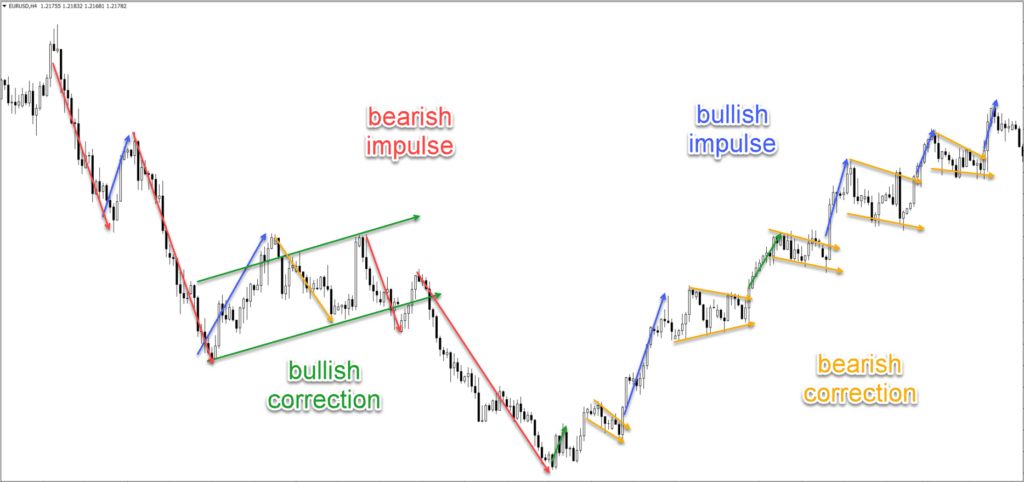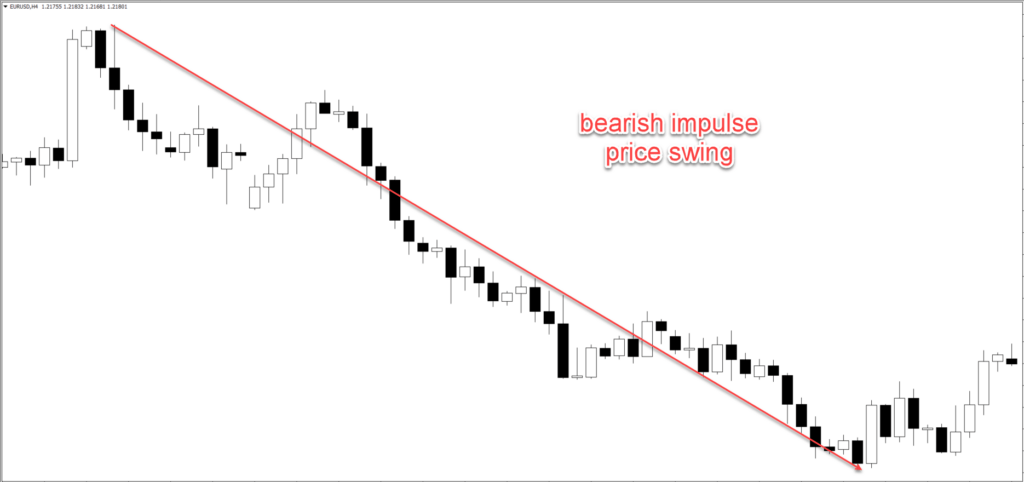- A price swing is when a large group of candles shares a direction on the chart
- There are only two ways a price swing can go, up or down.
- There are four types of swings: bullish impulse, bullish correction, bearish impulse, bearish correction
- Price swings help with identifying price patterns
- Swing trading is one of the most popular trading strategies for FX
Price Swings In Forex - What Are They?
A price swing is a group of candlesticks where the majority of candles share a common direction and character together:- Direction is either bullish or bearish.
- Character is either impulsive or corrective price movement (impulse and correction Forex).
- Bullish impulse
- Bullish correction
- Bearish impulse
- Bearish correction
 Usually, a price swing consists of 5 candles or more. There is no maximum. But eventually, old price swings end and new price swings start.
How? Once the majority of candles share a different direction or character, one price swing has probably ended at the recent high or low and a new price swing has started.
Usually speaking, one price swing ends and a new price swing starts when price action reaches a key support and resistance zone when reversal and continuation candlestick patterns emerge, and when price action makes a bounce or breakout.
Usually, a price swing consists of 5 candles or more. There is no maximum. But eventually, old price swings end and new price swings start.
How? Once the majority of candles share a different direction or character, one price swing has probably ended at the recent high or low and a new price swing has started.
Usually speaking, one price swing ends and a new price swing starts when price action reaches a key support and resistance zone when reversal and continuation candlestick patterns emerge, and when price action makes a bounce or breakout.
Why Are Price Swings Useful?
Forex price swings help identify the price patterns. By connecting the price swing together, traders can see chart patterns and Elliott Wave patterns. Price swings also offer traders vital information about what to expect from the current price swing, next price swing, and even price swings further into the future. Traders can use this information for their trading decisions on entries, stop loss placement, target placement, and trade management. Price swings are a very useful part of any Forex swing trading strategy. Impulse and correction add another layer of information besides the trend. The trend is key for understanding the long-term flow and price movement. But price swings add information about the short-term price movements. For instance, if the price swing is showing strong movement against the trend, then traders need to be careful about trading with the trend. Forex price swings are useful for all time frames, including swing trading time frames.What Is Impulsive Price Action?
An impulse in Forex trading means quick price action into one direction, bullish or bearish impulse. An impulse is also called momentum or impulsive price action. There are 3 main rules for impulsive price action:- Most of the candles (at least 60-65%) in the price swing belong to one direction (bullish or bearish).
- The impulsive direction has larger candles than candles in the opposite direction of the impulse.
- The impulsive direction has a candlestick close near the candle high or low (a bullish impulse has a candle close near the high and a bearish impulse has a candle close near the low).

What Is Corrective Price Action?
A corrective wave in Forex trading means one price swing that is slow, choppy, and mostly moves sideways (not up or down). A corrective wave is also called consolidation, range, or correction. There are 3 main rules for corrective price action:- Most of the candles are a mixture of bearish and bullish (one of the two directions is not dominant).
- Most of the candles are smaller in size with more indecision candles.
- Many of the candle closes are not near the candle high or candle low.
 This explains impulse and correction Forex. There are a few impulse correction indicators. Of course, traders can use an oscillator for understanding price action. An oscillator like the Awesome Oscillator or the ecs.MACD:
This explains impulse and correction Forex. There are a few impulse correction indicators. Of course, traders can use an oscillator for understanding price action. An oscillator like the Awesome Oscillator or the ecs.MACD:
- Bullish impulse: when the oscillator bars are above the zero line and growing.
- Bullish correction: when the oscillator bars are above the zero line but declining.
- Bearish impulse: when the oscillator bars are below the zero line and declining.
- Bearish correction: when the oscillator bars are below the zero line but growing.
 Now let’s review impulse and correction for trading purposes.
Now let’s review impulse and correction for trading purposes.
Swing Trading For Beginners - Is It That Hard?
Most traders see price swings in Forex as a semi-difficult concept so beginning traders are advised to practice first. Beginning traders need to acquire more experience and practice before they actively trade ideas based on Forex swing trading. Traders can use price swings in dozens of ways and is also a useful method for swing trading for beginners. But a relatively simple concept is to trade a breakout after a clear impulsive price swing. The two main advantages are this:- Traders avoid trading the impulse price swing too early (when perhaps the other direction is still dominant).
- They also wait for an extra confirmation (the breakout) which means traders avoid trading the impulse when it’s ending.


 Amazon
Amazon